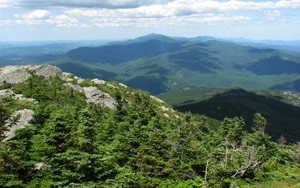The trail up Burnt Rock Mountain in north-central Vermont is a consistently rugged scramble up exposed granite ledge, the kind that makes ribbons out of hiking boots. J and I summited around 1 p.m. and our packs, which had begun to feel like clinging monkeys, crashed to earth with a synchronous clatter. North of us loomed the Allans: Ethan and Ira, two 3,000- plus-foot peaks. Beyond them, Camel’s Hump – Vermont’s own version of Devil’s Tower.
“She’s impressive, I’ll give her that,” said J, sucking deeply from his water bottle, taking in the 4,083-foot summit that rose, shimmering, in the hazy, late-summer air. We had two quarts of water between us and food for one more day on the trail. Eight hours of light left and 16 miles to go. Heat rose in waves and left our shirts wet to the touch.
I considered responding, but decided instead to conserve my energy. We pushed on.
Spanning 270 miles from the Massachusetts border to Canada, the Vermont Long Trail serves as a pristine example of extraordinary goodness. Conceived in 1910 and finished in 1930, the Long Trail is the oldest long-distance hiking trail in the country.
The trail is a hodgepodge of varied terrains and ecosystems, sometimes a green, lush stroll through hardwood glens and beaver meadows, sometimes a vertical accent through boreal fir and over wind-battered bedrock. Along the way it traverses most of Vermont’s major mountain peaks, Camel’s Hump included.
Some people hike the trail in one continuous trip, a jaunt that will take a person who is in good physical shape about 24 days (this estimate allows for a day or two of dawdle). Many others chip away at the trail section by section, whenever they find the time.
If you’ve never hiked on the Long Trail, I’d strongly encourage it. Start by picking up a copy of the Green Mountain Club guidebook (if you can’t find it in a local bookstore, go to www.greenmountainclub.org). This handy little reference guide offers mile by mile information and covers everything you’ll need to plan a hike, be it a weekend 20-miler or the whole 270-mile kit and caboodle.
When you’re out on the Long Trail, you’ll quickly learn that your I-can-do-this-many-miles-in-a-day estimates were egregiously optimistic. By about the 13th mile, your knees will feel like Kirk Gibson’s. You’ll curse your poor packing job and marvel at ridiculous items you considered to be bare essentials. You’ll come to see yourself as the main course in a black fly buffet line.
But the bad is easily outweighed by the good. Beyond the vistas, wildlife, and peaceful cadence of the trail, a hiker is ever conscious of the value in his or her toil. There’s solace in achievement on your own terms, in climbing a mountain instead of riding a chairlift, in walking clear across the state. There’s a deep satisfaction in earning something.
We summited Camel’s Hump in early evening, following a quartz-flecked ribbon of path through alpine vegetation – pink flowering bilberry, mountain sandwort, and hare’s-tail cottongrass – plants that perched delicately where they could find scraps of soil. Light fell in panes through cirrus clouds onto Lake Champlain, which spread before the Valley of Vermont like pale glass. J took in the view looking north, standing exactly where the bedrock fell into sky. Beyond him rose Mansfield, Belvidere, and Owl’s Head in Canada, mountains we would come to know intimately on future hikes.
As he turned to face me his stooped body bore the mark of a 30-mile hike with a 40-pound pack, but his eyes were peaceful like a man in church. His smile was roughly the size of Mount Washington looming on the eastern horizon.
“Will you look at that, Dave,” he said.
For another hour we did.


